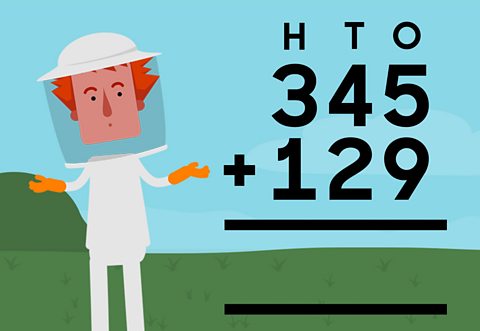Column addition is also known as vertical calculations.
Oh, I didn’t know you kept bees Jerry. How many have you got?
232? Oh look, Albert’s found you some more.
Ah! There you go, 95 more bees for your hive.
So how many have you got in total now?
Oh, don’t worry. We can use number columns.
Number columns allow you to take large numbers and add them together easily.
It does this by breaking the sum down into place value headings. And then, adding the numbers together in each column separately.
First the ones, in this case, five and two. Adding those numbers together we get seven.
Seven is the final number of our total.
Righto. On to the tens.
Adding together nine and three gives us 12. This number is made of two digits. One ten and two ones.
When this happens, you take the ones and put them into our final total and carry the tens over to the next sum.
We only have one number in the hundreds column. So we simply add the remaining number to that and then boom!
We’ve worked out you’ve got 327 bees in your hive.
All with the help of number columns.
See Albert, they’re not so bad. Oh eh… right. No problem, just RUN!

When writing down sums, separate the numbers into ones, tens, hundreds and thousands. List the numbers in a column and always start adding with the ones first.
- Estimate first and check afterwards - it's a good idea to estimate a rough answer first and then check your actual answer.
- Order doesn't matter - remember that 345 + 129 is the same as 129 + 345.
- Key words - look out for these words in problems: total, sum, altogether, more. They all indicate an addition calculation.

More on Number and number processes
Find out more by working through a topic
- count8 of 25

- count9 of 25

- count10 of 25

- count11 of 25
